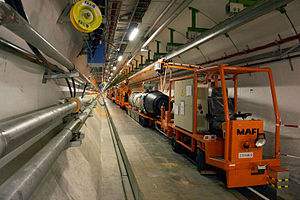Large Electron-Positron Collider
The Large Electron-Positron Collider (LEP for its acronym in English: Large Electron-Positron collider) was an accelerator-collider circular e-e+ about 27 km long, created in 1989 and in operation until 2000. Located 100 meters underground on the grounds of the European Organization for Nuclear Research, on the border between France and Switzerland, it was replaced by the Large Hadron Collider. It was the last step of the CERN accelerator complex, and in it the electrons and positrons were injected and accelerated to the final collision energy through the use of radiofrequency cavities. A system of dipole magnets bent the electron and positron beams, forcing them to follow a circular path.
In the LEP, electrons and positrons circulated in opposite directions at relativistic speeds (close to c, grouped in bunches) approximately 1.6 cm long and with a section of 0. 3×0.01mm².
There were eight collision points, four of which had several experiments installed: ALEPH, DELPHI, L3 and OPAL.
The Large Electron-Positron Collider started operations in August 1989 and although it was originally designed for the production of Z0 bosons (whose mass is 91.2 GeV/c 2), with energies per beam predicted for its first phase of around 45 GeV and luminosities of 1031 cm-2 s-1, the various improvements that were introduced in recent years in it (including the installation of superconducting cavities) made it possible to reach energies per beam of up to 104.5 GeV.
The second phase of the LEP particle accelerator was called LEP 2 (also LEP200 or LEP-II), in which the collision energy in the center of mass was increased above the 130 GeV. This increase allowed the production of pairs of W± and Z0 bosons. It was expected that the successive increases would even reach the threshold for the production of new particles, such as the Higgs boson.
The collision energies reached in the center of mass system in each year of operation, and the corresponding integrated luminosity collected in the DELPHI detector, can be seen in the following table.
| Energy (GeV) | Date | Luminous (pb)-1) |
|---|---|---|
| 130-136 | November 1995 | 6 |
| 161 | July/August 1996 | 10 |
| 172 | October/November 1996 | 10 |
| 183 | 1997 | 54 |
| 189 | 1998 | 158 |
| 192 | July 1999 | 26 |
| 196 | July/August 1999 | 77 |
| 200 | August/September 1999 | 84 |
| 202 | October/November 1999 | 41 |
| 203-208 | 2000 | 224 |
Some of the LEP's infrastructure (particularly its 27 km toroidal tunnel) has been used to build the Large Hadron Collider.
Contenido relacionado
Curie (unit)
Microbotics
NetBEUI
